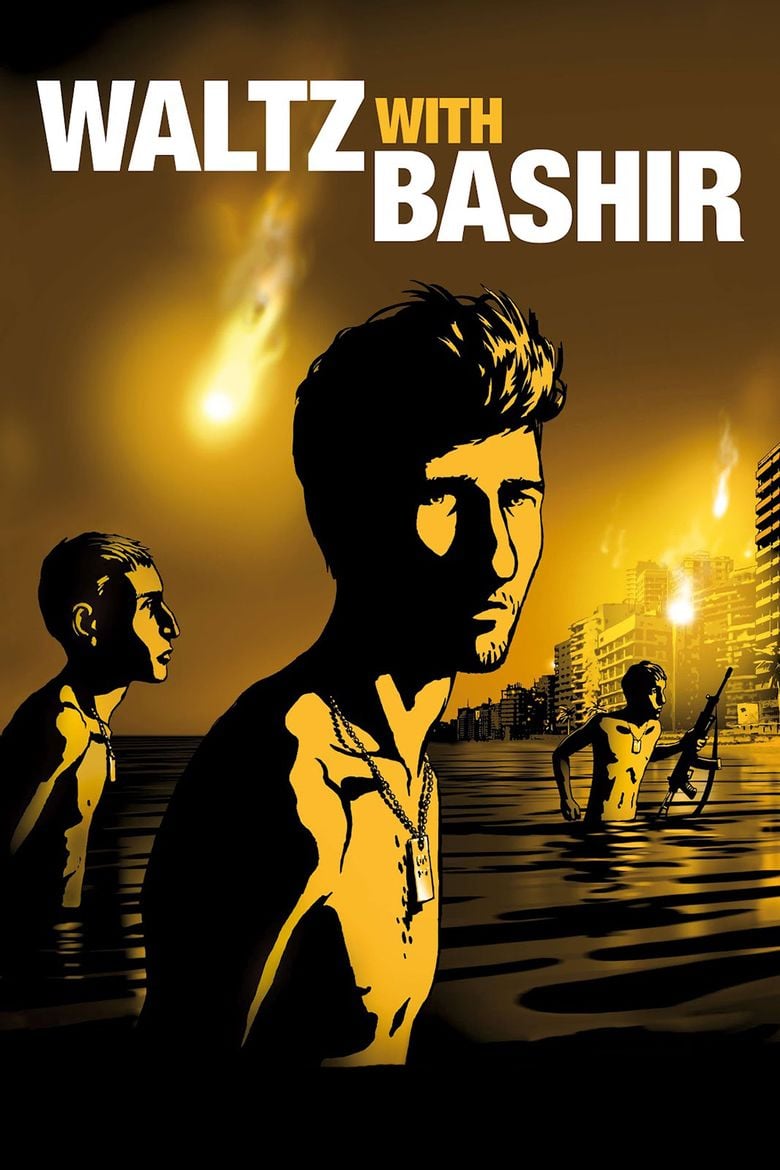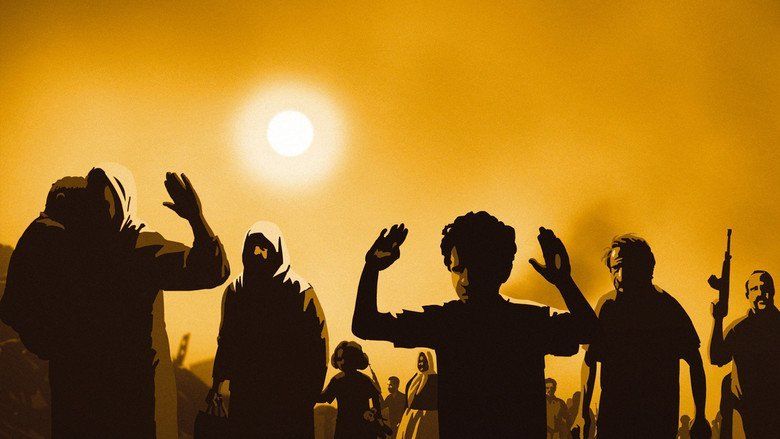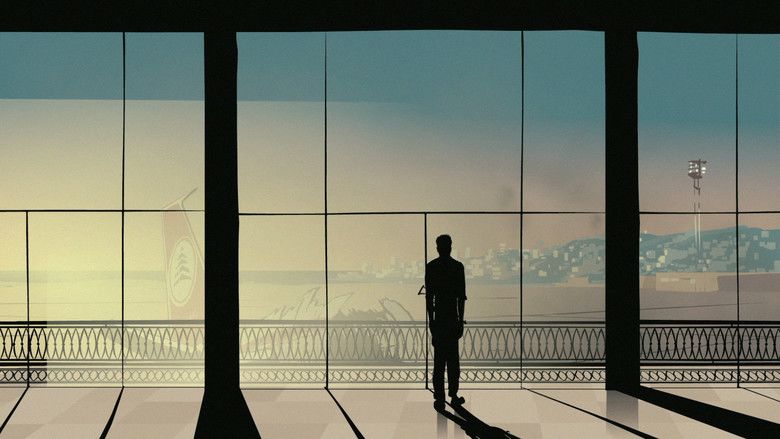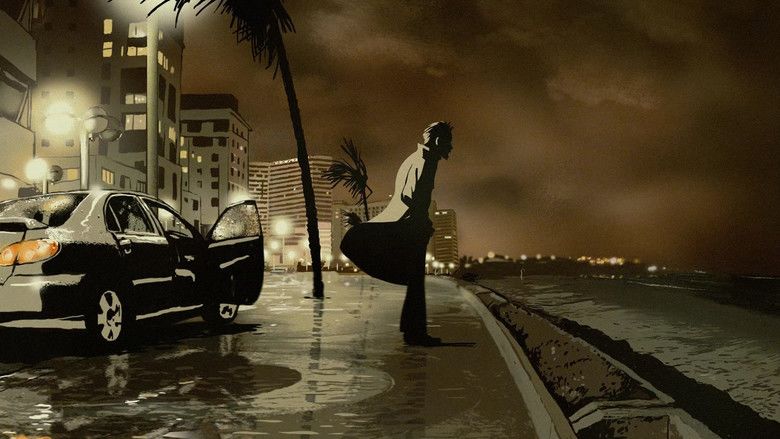Waltz with Bashir
8 /10 1 Votes
Duration Country IsraelGermanyFrance | 8/10 IMDb Genre Documentary, Animation, Biography Writer Ari Folman | |||||||||||||||||||||||||||||||||
 | ||||||||||||||||||||||||||||||||||
Cast Ari Folman (Himself (voice)), (Himself (voice)), Dror Harazi (Himself (voice)), Ronny Dayag (Himself (voice))Similar movies You Don't Mess With the Zohan , Munich , Bil'in habibti , Paradise Now , Rise of the Guardians , Dumbo | ||||||||||||||||||||||||||||||||||
Waltz with Bashir (Hebrew: ואלס עם באשיר, translit. Vals Im Bashir) is a 2008 Israeli animated war documentary film written and directed by Ari Folman. It depicts Folman in search of his lost memories of his experience as a soldier in the 1982 Lebanon War.
Contents
- Waltz with bashir trailer
- Plot
- Cast
- Title
- Production
- Release
- Reception of the film
- Lebanon screening
- Top ten lists
- Awards and nominations
- References

This film and $9.99, also released in 2008, are the first Israeli animated feature-length films released theatrically since Alina and Yoram Gross's Ba'al Hahalomot (1962). Waltz with Bashir premiered at the 2008 Cannes Film Festival where it entered the competition for the Palme d'Or, and since then has won and been nominated for many additional important awards while receiving wide acclaim from critics. It won a Golden Globe Award for Best Foreign Language Film, an NSFC Award for Best Film, a César Award for Best Foreign Film and an IDA Award for Feature Documentary, and was nominated for an Academy Award for Best Foreign Language Film, a BAFTA Award for Best Film Not in the English Language and an Annie Award for Best Animated Feature.

The film is officially banned in Lebanon.

Waltz with bashir trailer
Plot

In 1982, Ari Folman was a 19-year-old IDF infantry soldier. In 2006, he meets with a friend from that period, who tells him of the nightmares he's having connected to his experiences from the Lebanon War. Folman is surprised to find that he recalls nothing from that period. Later that night he has a vision from the night of the Sabra and Shatila massacre, the reality of which he is unable to clearly recall. In his memory, he and his soldier comrades are bathing at night by the seaside in Beirut under the light of flares descending over the city.
Folman rushes off to meet a childhood friend, who advises him to seek out others who were in Beirut at the same time, to understand what happened there and to revive his own memories. Folman converses with friends and other soldiers who served in the war, among others a psychologist, and Israeli TV reporter Ron Ben-Yishai, who covered Beirut at the time. Folman eventually realizes that he "was in the second or third ring" of soldiers surrounding the Palestinian refugee camp where the carnage was perpetrated, and that he was among those soldiers firing flares into the sky to illuminate the refugee camp for the Lebanese Christian Phalange militia perpetrating the massacre inside. He concludes that his amnesia stemmed from his feeling as a teenage soldier that he was as guilty of the massacre as those who actually carried it out. The film ends with animation dissolving into actual footage of the aftermath of the massacre.
Cast
The film contains both fictional composites of real-life figures and actual living people.
Title
The film takes its title from a scene in which Shmuel Frenkel, one of the interviewees and the commander of Folman's infantry unit at the time of the film's events, grabs a light machine gun and "dances an insane waltz" (to the tune of Chopin's Waltz in C-sharp minor) amid heavy enemy fire on a Beirut street festooned with huge posters of Bashir Gemayel. Thematically, the film's title is a symbolic description of the "Waltz", which is a dance for a couple, that Folman is "dancing" with his memories from the war in Lebanon. The title also refers to Israel's short-lived political waltz with Bashir Gemayel as president of Lebanon. Others have speculated that the title is a reference to Kurt Vonnegut's satirical novel Slaughterhouse-Five, or The Children's Crusade: A Duty-Dance with Death.
Production
The film took four years to complete. It is unusual in it being a feature-length documentary made almost entirely by the means of animation. It combines classical music, 1980s music, realistic graphics, and surrealistic scenes together with illustrations similar to comics. The entire film is animated, excluding one short segment of news archive footage.
The animation, with its dark hues representing the overall feel of the film, uses a unique style invented by Yoni Goodman at the Bridgit Folman Film Gang studio in Israel. The technique is often confused with rotoscoping, an animation style that uses drawings over live footage, but is actually a combination of Adobe Flash cutouts and classic animation. Each drawing was sliced into hundreds of pieces which were moved in relation to one another, thus creating the illusion of movement. The film was first shot in a sound studio as a 90-minute video and then transferred to a storyboard. From there 2,300 original illustrations were drawn based on the storyboard, which together formed the actual film scenes using Flash animation, classic animation, and 3D technologies.
The original soundtrack was composed by minimalist electronic musician Max Richter while the featured songs are by OMD ("Enola Gay"), PiL ("This is Not a Love Song"), Navadey Haukaf (נוודי האוכף )("Good Morning Lebanon", written for the film), The Clique ("Incubator"), and Zeev Tene (a remake of the Cake song "I Bombed Korea", retitled "Beirut"). Some reviewers have viewed the music as playing an active role as commentator on events instead of simple accompaniment.
The comics medium, in particular Joe Sacco, the novels Catch-22, The Adventures of Wesley Jackson, and Slaughterhouse-Five, and painter Otto Dix were mentioned by Folman and art director David Polonsky as influences on the film. The film itself was adapted into a graphic novel in 2009.
Release
Waltz with Bashir opened in the United States on 25 December 2008 in a mere five theaters, where it grossed $50,021 in the first weekend. By the end of its run on 14 May 2009, the film had grossed $2,283,849 in the domestic box office. Overseas, Waltz earned $8,842,000 for a worldwide total of $11,125,849.
Reception of the film
As of March 2017, the film holds a 96% "fresh" rating on review aggregator website Rotten Tomatoes based on 145 critics for an average of 8.3/10; the general consensus states: "A wholly innovative, original, and vital history lesson, with pioneering animation, Waltz With Bashir delivers its message about the Middle East in a mesmerizing fashion."
indieWire named the film the tenth best of the year, based on the site's annual survey of 100 film critics. Xan Brooks of The Guardian called it "an extraordinary, harrowing, provocative picture." The film was praised for "inventing a new cinematographic language" at the Tokyo Filmex festival. The World Socialist Web Site's David Walsh described it as a "painfully honest" anti-war film and "one of the most extraordinary and haunting films at the Toronto film festival." Despite the positive critical reception, the film was only moderately commercially successful in Israel itself.
Lebanon screening
The film is banned in some Arab countries (including Lebanon), with the most harsh critics in Lebanon, as the film depicts a vague and violent time in Lebanon's history. A movement of bloggers, among them the Lebanese Inner Circle, +961 and others have rebelled against the Lebanese government's ban of the film, and have managed to get the film seen by local Lebanese critics, in defiance of their government's request on banning it. The film was privately screened in January 2009 in Beirut in front of 90 people. Since then many screenings have taken place. Unofficial copies are also available in the country. Folman saw the screening as a source of great pride: "I was overwhelmed and excited. I wish I could have been there. I wish one day I'll be able to present the film myself in Beirut. For me, it will be the happiest day of my life."
Top ten lists
The film appeared on many critics' top ten lists of the best films of 2008.
It was also ranked #34 in Empire magazine's "The 100 Best Films Of World Cinema" in 2010, and #4 in Current TV's "50 Documentaries to See Before You Die" in 2011.
Awards and nominations
Waltz with Bashir became the first animated film to have received a nomination for either an Academy Award or a Golden Globe Award for Best Foreign Language Film. Also the first R-rated animated film to be considered for those honors. It also became the first Israeli winner of the Golden Globe Award for Best Foreign Language Film since The Policeman (1971), and the first documentary film to win the award.
It was unsuccessfully submitted for an Academy Award for Best Animated Feature nomination, and became ineligible for the Academy Award for Documentary Feature when the Academy announced its new rule to nominate only documentaries which have had a qualifying run in both New York and Los Angeles by 31 August.
The film was also included in the National Board of Review's Top Foreign Films list. Folman won the WGA's Best Documentary Feature Screenplay award and the DGA's Outstanding Directorial Achievement in Documentary award for creating the film. Folman also received nominations for Annie Awards and BAFTA Awards for Best Animated Feature, but lost both awards to Kung Fu Panda and WALL-E respectively.
References
Waltz with Bashir WikipediaWaltz with Bashir IMDb Waltz with Bashir themoviedb.org
